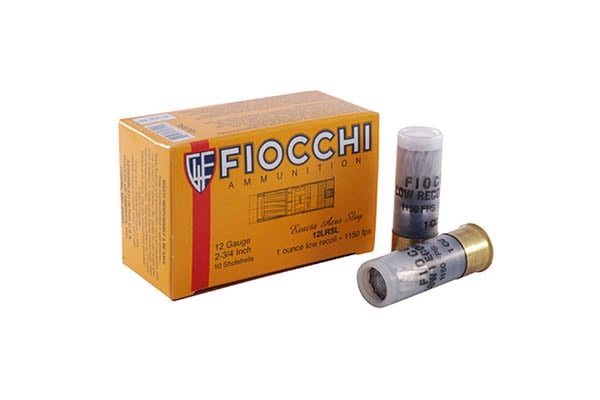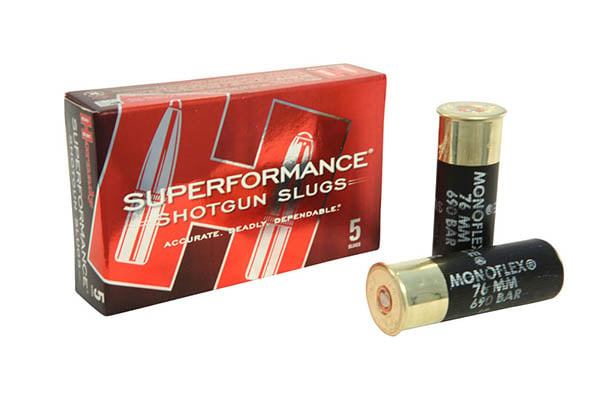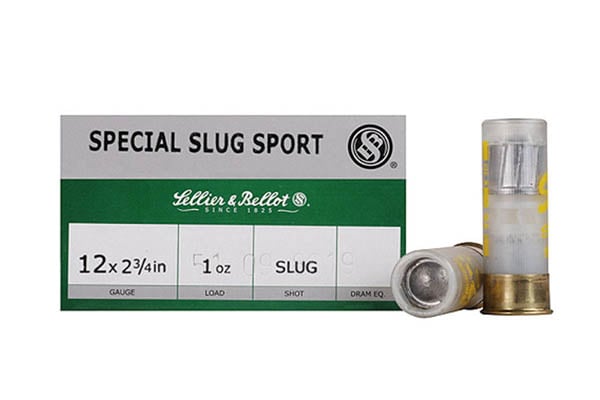
Last Updated on
As fall hunting season approaches, hunters all over the country brush the dust off their firearms in anticipation of fruitful hunting trips. For some, that is a good old rifle, for others, even those determined to get a white-tailed trophy, a shotgun is the weapon of choice. Or a necessity as laws and regulations in many states and counties prohibit rifle use during deer season. Whether you need to abide by the rules or didn’t think for a second about choosing a different gun, knowing your ammunition options is a must. You won’t use birdshot to bring down a deer (I do hope you won’t). Shotgun slugs are the best candidates for the job, if you have to use a shotgun, that is. But slugs are quite numerous, and each type boasts its own set of features. In this article, we’ll break down the various types of shotgun slugs.
Table of Contents
Why Choose Shotgun Slugs?
Slug Varieties
Brenneke Slugs
Foster Slugs
Saboted Slugs
Wad Slugs
Sighting In and Testing
Smoothbore Shotguns
Rifled Barrel Shotguns
Conclusion
FAQs

Why Choose Shotgun Slugs?
A shotgun slug can be just as effective as a rifle round, albeit with a reduced range. Although the effective distance ranges between 100 and 150 yards, most shots end up being around 50-100 yards. Firing a slug at a deer over 100 yards away becomes somewhat unethical unless you truly know your slug will be accurate at an extended distance (more common for sabot slug users). That said, it can be discouraging to find that slug hunting is not an exact science, at least the ballistics portion of the hunt. A successful slug gun setup requires matching the right gun to the proper rifled or smoothbore barrel, and of course, you have to find the right slug brand to shoot out of the setup as well. But we’ve digressed enough, let’s gun down to slug classification.
Slug Varieties
Brenneke Slugs
German ammunition pioneer Wilhelm Brenneke developed the first modern shotgun slug, and this popular variety still bears his name today. These slugs are made from solid lead, and they have ridges that protrude from the side of the slug. Brenneke slugs have a wad attached to the projectile that serves as a gas seal and remains with the projectile even after it has been fired. This design improves the slug’s ballistic coefficient (BC) and stability in flight, helping to keep the slug on a relatively flat trajectory for a limited distance. Brenneke slugs are designed to be used with smoothbore shotguns. The solid slug design imparts a lot of energy to the target and improves overall penetration. The Brenneke company still manufactures slugs for the hunting and self-defense market today.
Foster Slugs
Several years after Brenneke developed his slug design in Europe, American Karl Foster created a similar slug for use in smoothbore barrels. Instead of utilizing a solid slug design like Brenneke, Foster slugs are made from softer lead and have a deep hollow cavity in the base. This hollow portion functions similarly to Brenneke’s attached wad and helps maintain trajectory throughout the slug’s flight. Foster slugs have wads like any shotgun shell, but they do not stay attached like they do in Brenneke slugs. Foster slugs also have ridges on the side of the slug, often called rifling, although these ridges do not spin the slug as you might have thought from the name. The rifling instead helps the slug travel down the barrel and through the choke tube safely. Unlike some other types of slugs, Foster slugs are power-swaged, not cast. This process involves pressing the slug into its final shape under high pressure, which can result in a more uniform and consistent product.

Saboted Slugs
Sabot slugs are a relatively new form of slug when compared to the Brenneke and Foster varieties. They provide increased accuracy and longer range than their traditional slug counterparts, but they are designed exclusively for rifled shotgun barrels. The term “sabot” refers to the plastic casing that encapsulates the slug, functioning as a type of shoe that seals the bore and engages with the rifling in the barrel. This engagement imparts a spin on the slug as it is fired, stabilizing its trajectory and significantly enhancing its accuracy. The slug enclosed within the sabot is typically smaller than the bore diameter, which allows the sabot to create an effective gas seal. The projectile itself can be made of a variety of materials like lead, copper, brass and steel. Saboted slugs boast accuracy unreachable for smooth-bored slug options mentioned above, but again, they are meant for shotguns with rifled barrels.

While Brenneke and Foster slugs can be used in either smoothbore or rifled barrels (with the drawback of fouling in rifled barrels), sabots are designed for use only in rifled shotgun barrels. Since the sabot slug gets a boost from the rifled barrel, the range and accuracy of these slugs is significantly increased. The copper jacket also encourages penetration when it hits the target. As you would expect, sabot slugs are more expensive (not to mention the cost of a rifled barrel if you don’t have one), but the advantages are clear for those who can’t get results with smoothbore slugs.
Wad Slugs
Wad slugs are a unique type of shotgun ammunition that stand between Foster slugs and sabot slugs. The primary distinctive feature of wad slugs is their key or web wall molded across the deep hollow (which is also present). The slugs are generally made from lead or a lead alloy and usually sport a smooth outer surface while being shaped like a bullet. Wad slugs are particularly preferable in situations where the shooter needs a versatile, accurate, and affordable ammunition option for medium-range engagements. They truly shine in smoothbore barrels, where their integrated design can leverage the bore’s characteristics for improved performance. In comparison, other types of slugs like the saboted or rifled slugs, while offering superior accuracy at long ranges, may not be as cost-effective or versatile as wad slugs, especially for medium-range shooting scenarios.
Sighting In and Testing
Sighting in any slug gun setup is absolutely necessary, and anyone who hunts without testing how slugs perform out of their gun is inviting a missed shot when the deer season opens. Fact is slugs are notoriously finicky, even out of the best shotguns. The only way to know your slug gun setup is dialed in is to hit the range and check out what sort of pattern it is firing. It’s wise to bring at least 3-4 different brands of slugs to experiment with as well. Often, hunters will sight in at 50-75 yards and then compare how the results change at 100 yards. As far as slug selection, you have two basic choices:
Smoothbore Shotguns
If you’re on a budget, or want to try the simple method of hunting with slugs first, you can just use your favorite hunting shotgun with a smooth barrel. Test out how rifled slug and Brenneke slugs perform out of the smoothbore, and select the best brand that works for you. Sometimes the addition of an improved cylinder choke can aid in slug accuracy, but don’t go any tighter than that.
Alternatively, if you’re not getting results with a cylinder or improved cylinder choke, you can opt to install a rifled choke and try sabot slugs out of your smoothbore. Honestly, you’re not going to see a ton of improvement using sabots with a rifled choke, but the investment cost is certainly far less than a rifled barrel. For our money, put the cost of the rifled choke towards the rifled barrel instead.

Rifled Barrel Shotguns
If you can’t get the smoothbore option to work effectively enough for you, or if you demand a higher level of performance out of your slugs, then buying a rifled barrel and spending a decent chunk of change on sabot slugs is your only option. That said, this investment will definitely pay dividends down the line, especially if you come across that once in a lifetime buck or plan to hunt every year. The testing premise remains the same here. Go to the range with several different sabot slug brands and see which performs best. Even with sabot slugs, performance can differ between different guns and rifled barrels.
Conclusion
As you can see, shotgun slugs offer a significant advantage in terms of power and accuracy for those involved in hunting. They provide the opportunity to engage targets at greater distances with more impact than traditional buckshot. Understanding the different types of slugs, their uses and capabilities is crucial for any shotgun owner. With this guide, you should now have a basic understanding of shotgun slugs and a way paved to make informed decisions based on your specific needs. Remember, the key to mastering the use of shotgun slugs lies in practice and familiarization with your firearm. So, load up, head out to the local gun range, and discover the potential these remarkable rounds can grant you.
Check out other articles on shotguns, compiled by the Gritr Sports Team:
- 12 Gauge vs. 20 Gauge: Choosing a Shotgun for Your Application
- 7 Best Home Defense Tactical Shotguns – 2023 Guide
- Mossberg Shotgun Reviews: From Pump-Action to Semi-Auto
FAQs
What are shotgun slugs?
Shotgun slugs are a type of ammunition used in shotguns that consist of a single, large projectile, rather than the multiple pellets found in buckshot rounds.
What are the different types of shotgun slugs?
There are several types of shotgun slugs, but the most prominent ones are full-bore slugs, including Foster and Brenneke slugs; and Sabot slugs meant for rifled shotgun barrels.
When should I use shotgun slugs?
Shotgun slugs are typically used in hunting and self-defense scenarios where more power and accuracy are required. Some states ban deer hunting unless the shooter carries a shotgun. Slugs are also more accurate at longer distances than other shotgun projectiles.




Leave a Reply